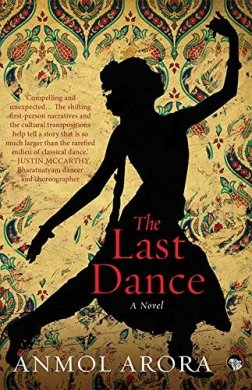
|   |

|   |
The Last Dance: A lost opportunity - Madhur Gupta e-mail: madhurgupta04@gmail.com September 21, 2019 
The first thought that strikes after reading The Last Dance is of the brutal violence that spills over the entire extant of the book. From the political rebellions, murders, gurus slapping disciples, gurus raping disciples, the book seems to be dripping with gory details of humankind's wild side, more suited for a thriller than for a subject of classical arts. The primary plot commences with the protagonist Ayla's family being caught in midst of the Kurdish rebellion, her grandfather getting executed, her family imposing self-exile running away to India, and their initial struggles of settling down in a foreign land. Another parallel storyline running is that of Chandrashekar, son of a renowned Bharatanatyam guru in Thanjavur, estranged from his father for reasons one can't fathom, wanting to make his own name in the industry and like Ayla's family self-imposing an exile and coming to Delhi. The book attempted to explore the complex relationship a Guru-shishya share between them, but it seems the writer who is not from the arts scene chose to be extravagantly surrealistic and ended up creating some incredible scenarios. Like for example, the scene where Guru Chandrashekar takes his troupe for a performance at India Habitat Centre to participate in a supposed International Dance Festival. The organiser of this festival had made eclectic choices of lining up from contemporary to ballet, from belly dance to Bharatanatyam. 'The crowd blew kisses, screamed, and cheered... a hoot went up', such was the ambiance of this dance festival. Now anyone from the Indian arts scene would know that a Guru who comes from generations of tradition, is a stickler for classicism, has 'purity' running deep in his blood will NEVER, just about never make his or her troupe participate in such an event. The storyline gets further fantastical when Ayla decides to improvise on stage to grab the attention of an audience entranced by the preceding mass appealing dance styles. But therein lacks the research Anmol Arora, the author, has put in. 'I increased the pace of the movements to strike a chord with the audience and improvised my expressions to fit the tempo' - what exactly was she dancing to? A Varnam, a Thillana, a Jatiswaram? Moreover since there is no mention of a live orchestra, one assumes the recital was done on pre-recorded music. How does one increase the tempo and 'beat one's feet faster' to a music which has already been set to a particular rhythm, unless of course one is out of talam. This is just one example. The Last Dance seems to be full of such befuddling storylines which leaves the reader, especially those from the line of music and dance who usually make up for a major readership of art based books, exhausted from the unrealistic treatment of the plots. When Guru Chandrashekar slaps Ayla and thunders, "This was supposed to be a classical dance performance, not a vulgar act", one cannot comprehend why did he participate in such a muddled event altogether and then blame his disciple for living up to the expectations of an uncultivated audience! While one can appreciate the fact that in reality there truly are instances where Guru and shishyas fall out, the manner in which the author made Ayla return to Pratishtha, Chandrashekar's dance school full of nasty attitude, only to leave again, and come back again seems just over the top dramatic. Talking of being overtly dramatic, Ayla's rape instance which could have been treated with much nuance since it's a highly sensitive subject seems to be right out of yesteryear's Bollywood movie where a big bad villain dupes a maiden in distress and takes advantage of her. Even a simpleton could see through the conniving attitude of Ayla's second 'Guru' Ranmohan after reading the first two paragraphs, but not her and not her parents who blindly let her go to this person with suspicious reputation without once chastising her for her arrogant behaviour with her first Guru Chandrashekar. The linear treatment of subplots of a fallout, tragedy, reunion just doesn't evoke a sense of curiosity in the reader, because as mentioned before, one can see and guess the succeeding incidents unravelling from a mile ahead! There are many loose threads and under development of relationships happening in the book that one feels lost again to understand the relevance of introducing a character altogether. Like who was Sudha? Was she Chandrashekar's love interest, a friend, a colleague, his dance school's manager? There are so many questions which are left unanswered. Fiction is fine, but it still has to be based on certain realistic facts if one wants to reach out to the audience and make them believe and relive the tales told. If The Last Dance is the first exposure for a layman to our high arts, Arora is losing the opportunity of introducing the masses to the world which not only heals but uplifts the soul if practised. Book: The Last Dance Publisher: Speaking Tiger Price: INR 499 Odissi dancer Madhur Gupta is a disciple of Guru Sharon Lowen. He contributes to national dailies like The Hindu, The Times of India, The Asian Age, The Indian Express covering at large the Indian classical dance and music scene of the subcontinent. Post your comment Unless you wish to remain anonymous, please provide your name and email id when you use the Anonymous profile in the blog to post a comment. All appropriate comments posted in the blog will also be featured in the site. |